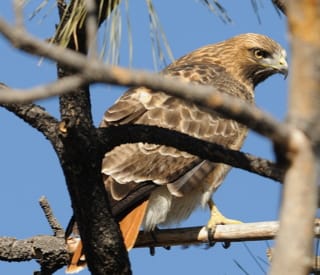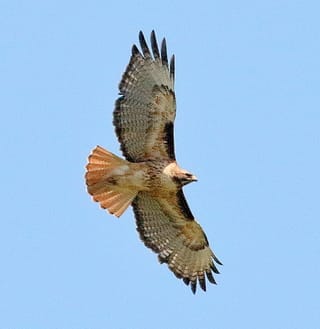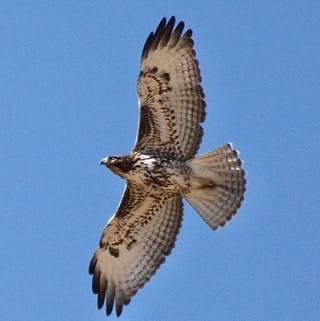Initially this guide displays common birds of all types that are flying right now in our area. Use the selectors below to view rare birds, view birds flying any time, restrict the output to a certain shape of bird, or search by name.
New Mexico is on the western edge of the Central Flyway which is one of the major migration pathways between north and south for birds traveling between breeding and wintering grounds along the Rocky Mountains. This has resulted in the state having an incredible diversity of birds with over 550 different species reported. A little more than half of this number are sighted annually on the Pajarito Plateau. Some of these birds are full-time residents, some migrate here for a few weeks or months, and other are only seen briefly as they pass through the region.
This guide features many of the birds known to frequent Los Alamos county by when they are likely to be seen in the area. You can get additional information on local birds by joining PEEC Birders or going to the eBird website. eBird also includes lists of rare bird sightings and birding hot spots.
Bird References
Birdweb
Cornell Lab of Ornithology
eBird
eNature
Institute for Bird Populations
National Audubon Society
New Mexico Ornithology Society
What Bird
xeno-canto
Subject Area Experts (all guides)
Steve Cary (butterflies)
Beth Cortright (insects)
Terry Foxx (invasive plants)
Leslie Hansen (mammals)
Richard Hansen (fish, mammals)
Dorothy Hoard (butterflies, trees)
Chick Keller (flowers, herbarium)
Shari Kelley (geology)
Kirt Kempter (geology)
Garth Tietjen (reptiles)
David Yeamans (birds)
Web Development and Content Management
Pat Bacha
Jennifer Macke
Graham Mark
Akkana Peck
Contact
Please contact us for local nature questions and sightings. We welcome comments, corrections, and additions to our guides.
For more information about local nature, please visit our Nature Blog or subscribe to PEEC This Week.
Make Selection
 Photo: adult by Marion Stelts  Photo: adult by Bob Walker  Photo: immature by J.N. Stuart |  Red-tailed Hawk, ChickenhawkRTHA (Buteo jamaicensis)Family: Accipitridae (Hawks and Eagles) Size: 18 - 25 in (46 - 64 cm) Flies: Jan 01 - Dec 31 Morphology: females larger than males; large amount of variability in overall color depending on subspecies and region (light, intermediate and dark); young birds have mottled white patches on back and brown tail Status: native; common Food source: small mammals (voles, rats, rabbits, and ground squirrels), birds, and reptiles (especially snakes) Habitat: forests, open country, agricultural field and urban areas Typical location: Los Alamos Airport The Red-tailed Hawk is the common hawk in the area. It can be seen flying overhead with slow, measured wing beats or soaring upward doing slow turns. It often perches next to highways looking for prey. The birds mate in spring and build a nest made of sticks lined with soft materials. Nests are usually located high up in a tree or on a cliff ledge. However, they can also be found on high buildings or towers. The females lay from 1 to 5 eggs which hatch in about a month. The babies fledge at around 6 to 7 weeks old but will stay with their parents for a few weeks longer. Info Photos Distribution Frequency |
